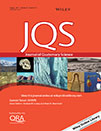Climate change and resilience of deciduous Nothofagus forests in central–east Chilean Patagonia over the last 3200 years
ABSTRACT
We examine the response of Nothofagus forests to climate change and disturbance regimes over the last 3200 years near Coyhaique (45°S), central–east Chilean Patagonia, using fine-resolution pollen and charcoal records from lake sediment cores. Closed-canopy deciduous Nothofagus forests have dominated the region with little variation until the arrival of Chilean–European settlers, suggesting a predominance of cool-temperate and wet conditions. Within this state we identify centennial-scale episodes of forest fragmentation, increase in littoral macrophytes and volcanic/paleofire disturbance between 2700 and 3000 cal a BP, 2200 and 2500 cal a BP and over the last ∼250 years, which we interpret as intervals with negative hydrologic balance. Natural variability caused little impact on the physiognomy and composition of the vegetation in pre-European time, in contrast to the accelerated shift that started during the late 19th century associated with deforestation, homogenization and synchronization of ecosystem changes at the landscape level, and spread of exotic plant species brought by Chilean and European settlers during a warm/dry interval. The resilience of deciduous Nothofagus forests to natural disturbance regimes and climate change was exceeded by large-scale human disturbance since the late 19th century by fire, timber exploitation and livestock grazing. These disturbances caused an ecosystem shift towards artificial meadows and scrublands with frequent high-magnitude fires. Copyright © 2017 John Wiley & Sons, Ltd.




